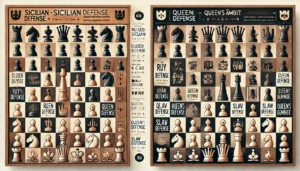Introduction
Advanced chess openings are the secret weapon of many successful players. By mastering these, you can gain a significant advantage from the very first move, setting the stage for a victorious game. In this article, we’ll dive into detailed opening theories, explore the advantages and disadvantages of various strategies, and learn how to counter common openings effectively.
Key Takeaways
- Understanding detailed opening theories gives you a strategic edge.
- Knowing the advantages and disadvantages helps you choose the best opening for each game.
- Being able to counter common openings ensures you stay in control of the board.
Outline
- Detailed Opening Theories
- Advantages and Disadvantages
- How to Counter Common Openings
Detailed Opening Theories
Mastering advanced chess openings starts with understanding the theories behind them. These theories form the foundation of your strategy, allowing you to make informed decisions from the very first move.
The Sicilian Defense

The Sicilian Defense is one of the most popular and powerful responses to 1.e4. It allows Black to counter-attack and create imbalances that can be advantageous. Key variations include the Dragon, Najdorf, and Scheveningen.
The Ruy López

The Ruy López, or Spanish Opening, is a classic and elegant opening for White, starting with 1.e4 e5 2.Nf3 Nc6 3.Bb5. This opening focuses on rapid development and control of the center, aiming for a strong, flexible position.
The Queen’s Gambit

The Queen’s Gambit (1.d4 d5 2.c4) is a dynamic opening that offers White control over the center. Accepting or declining the gambit leads to different game structures, each with its own strategic plans and counter-plans.
Advantages and Disadvantages

Every advanced chess opening comes with its own set of strengths and weaknesses. Understanding these can help you decide which openings to employ and when to use them.
The Sicilian Defense
Advantages:
- Creates dynamic and asymmetrical positions, making it harder for opponents to predict your moves.
- Provides excellent counter-attacking opportunities.
- Frequently used by grandmasters, demonstrating its effectiveness at high levels.
Disadvantages:
- Requires deep theoretical knowledge to avoid early pitfalls.
- Can lead to complex positions that are difficult to navigate for less experienced players.
The Ruy López
Advantages:
- Strong emphasis on piece development and control of the center.
- Leads to solid and flexible positions, allowing for various strategic plans.
- Often results in rich, maneuvering middle games.
Disadvantages:
- Can be countered by several well-known defenses, such as the Berlin Defense.
- Requires precise play to maintain the initiative and avoid simplifications.
The Queen’s Gambit
Advantages:
- Offers strong central control and rapid piece development.
- Leads to rich, strategic positions with long-term planning opportunities.
- Accepted variations can give White a lead in development.
Disadvantages:
- Declining the gambit can lead to solid but less ambitious positions for White.
- Requires understanding of various pawn structures and their implications.
How to Counter Common Openings

Knowing how to counter common openings ensures you can neutralize your opponent’s strategies and steer the game into positions where you feel comfortable.
Countering the Sicilian Defense
- Closed Sicilian: Avoid the main theoretical battles by playing 2.Nc3, aiming for a slower, strategic game.
- Alapin Variation: Play 2.c3 to avoid the main lines and steer the game into unique structures that can catch your opponent off guard.
Countering the Ruy López
- Berlin Defense: Respond with 3…Nf6, leading to solid and drawish positions, making it harder for White to press for a win.
- Schliemann Defense: Play 3…f5 to create sharp, tactical positions that can unbalance the game.
Countering the Queen’s Gambit
- Slav Defense: Respond with 2…c6, creating a solid structure that is hard for White to break down.
- Accepted Variation: Play 2…dxc4 to challenge White’s central control and aim for counter-play.
Conclusion
Mastering advanced chess openings gives you a significant edge over your opponents. By understanding detailed opening theories, weighing the advantages and disadvantages, and learning how to counter common openings, you can outsmart any opponent. Remember, the key is not just to know these openings but to practice and refine them continuously. With dedication and study, you’ll see your game improve and your victories increase.
Visit our website chesstacticshub.com for more in-depth guides and resources to help you master every aspect of chess strategy.
